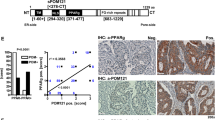Abstract
Peroxisome proliferator-activated receptor δ gene (PPARδ) is correlated with carcinogenesis of colorectal cancer, but the regulation of its gene transcription remains unclear. We herein report that AP1 binds the promoter and regulates PPARδ gene expression. With a luciferase reporter system, we identified a functional promoter region of 30 bp of PPARδ gene by deletion and electrophoretic mobility shift assays (EMSA). Using site-directed mutagenesis and decoy analyses, we demonstrated that AP1 bound the functional transcriptional factor binding site in a region extending from −176 to −73 of the PPARδ promoter, which was confirmed using EMSA and supershift assays. Consequently, inhibition of the AP1 binding site led to decreased PPARδ mRNA. Our study demonstrated that AP1 is the transcriptional factor that contributes to PPARδ expression in LoVo cells.







Similar content being viewed by others
References
Michalik L, Wahli W. Involvement of PPAR nuclear receptors in tissue injury and wound repair. J Clin Invest. 2006;116:598–606.
Desvergne B, Wahli W. Peroxisome proliferator-activated receptors: nuclear control of metabolism. Endocr Rev. 1999;20:649–88.
Schoonjans K, Staels B, Auwerx J. The peroxisome proliferator activated receptors (PPARs) and their effects on lipid metabolism and adipocyte differentiation. Biochim Biophys Acta. 1996;1302:93–109.
Willson TM, Brown PJ, Sternbach DD, Henke BR. The PPARs: from orphan receptors to drug discovery. J Med Chem. 2000;43:527–50.
Hansen MK, Connolly TM. Nuclear receptors as drug targets in obesity, dyslipidemia and atherosclerosis. Curr Opin Investig Drugs. 2008;9:247–55.
Torra IP, Chinetti G, Duval C, Fruchart JC, Staels B. Peroxisome proliferator-activated receptors: from transcriptional control to clinical practice. Curr Opin Lipidol. 2001;12:245–54.
Wang N. PPAR-delta in vascular pathophysiology. PPAR Res. 2008;2008:164163.
Meissner M, Hrgovic I, Doll M, Kaufmann R. PPARδ agonists suppress angiogenesis in a VEGFR2-dependent manner. Arch Dermatol Res. 2011;303:41–7.
Kostadinova R, Montagner A, Gouranton E, Fleury S, Guillou H, et al. GW501516-activated PPARβ/δ promotes liver fibrosis via p38-JNK MAPK-induced hepatic stellate cell proliferation. Cell Biosci. 2012;2:34.
Kliewer SA, Lehmann JM, Milburn MV, Willson TM. The PPARs and PXRs: nuclear xenobiotic receptors that define novel hormone signaling pathways. Recent Prog Horm Res. 2000;54:345–67.
Spiegelman BM. PPAR-gamma: adipogenic regulator and thiazolidinedione receptor. Diabetes. 1998;47:507–14.
He TC, Chan TA, Vogelstein B, Kinzler KW. PPARd is an APC regulated target of nonsteroidal anti-inflammatory drugs. Cell. 1999;99:335–45.
Takayama O, Yamamoto H, Damdinsuren B, Sugita Y, Ngan CY, et al. Expression of PPARd in multistage carcinogenesis of the colorectum: implications of malignant cancer morphology. Br J Cancer. 2006;95:889–95.
Harman FS, Nicol CJ, Marin HE, Ward JM, Gonzalez FJ, et al. Peroxisome proliferator-activated receptor-d attenuates colon carcinogenesis. Nat Med. 2004;10:481–3.
Reed KR, Sansom OJ, Hayes AJ, Gescher AJ, Winton DJ, et al. PPAR delta status and Apc-mediated tumorigenesis in the mouse intestine. Oncogene. 2004;23:8992–6.
Park BH, Vogelstein B, Kinzler KW. Genetic disruption of PPARd decreases the tumorigenicity of human colon cancer cells. Proc Natl Acad Sci USA. 2001;98:2598–603.
Gupta RA, Wang D, Katkuri S, Wang H, Dey SK, et al. Activation of nuclear hormone receptor peroxisome proliferator activated recaptured accelerates intestinal adenoma growth. Nat Med. 2004;10:245–7.
Zuo X, Peng Z, Moussalli MJ, Morris JS, Broaddus RR, et al. Targeted genetic disruption of peroxisome proliferator-activated receptor-delta and colonic tumorigenesis. J Natl Cancer Inst. 2009;101:762–7.
Gupta RA, Tan J, Krause WF, Geraci MW, Willson TM, et al. Prostacyclin-mediated activation of peroxisome proliferator-activated receptor δ in colorectal cancer. Proc Natl Acad Sci USA. 2000;97:13275–80.
Shao J, Sheng H, DuBois RN. Peroxisome proliferator-activated receptors modulate K-Ras-mediated transformation of intestinal epithelial cells. Cancer Res. 2002;62:3282–8.
Di-Poï N, Tan NS, Michalik L, Wahli W, Desvergne B. Antiapoptotic role of PPARβ in keratinocytes via transcriptional control of the Akt1 signaling pathway. Mol Cell. 2002;10:721–33.
Wang D, Wang H, Guo Y, Ning W, Katkuri S, et al. Crosstalk between peroxisome proliferator-activated receptor δ and VEGF stimulates cancer progression. Proc Natl Acad Sci U S A. 2006;103:19069–74.
Kwak H, Hwang I, Kim JH, Kim MY, Yang JS, et al. Modulation of transcription by the peroxisome proliferator-activated receptor δ-binding RNA aptamer in colon cancer cells. Mol Cancer Ther. 2009;8:2664–73.
Yang L, Olsson B, Pfeifer D, Jönsson JI, Zhou ZG, et al. Knockdown of peroxisome proliferator-activated receptor-β induces less differentiation and enhances cell-fibronectin adhesion of colon cancer cells. Oncogene. 2010;29:516–26.
Malnou CE, Brockly F, Favard C, Moquet-Torcy G, Piechaczyk M, et al. Heterodimerization with different Jun proteins controls c-Fos intranuclear dynamics and distribution. J Biol Chem. 2010;285:6552–62.
Chen W, Bowden GT. Activation of p38 MAP kinase and ERK are required for ultraviolet-B induced c-fos gene expression in human keratinocytes. Oncogene. 1999;18:7469–76.
Jochum W, Passegue E, Wagner EF. AP-1 in mouse development and tumorigenesis. Oncogene. 2001;20:2401–12.
Borner C. The Bcl-2 protein family: sensors and checkpoints for life-or-death decisions. Mol Immunol. 2003;39:615–47.
Conflicts of interest
None
Author information
Authors and Affiliations
Corresponding author
Rights and permissions
About this article
Cite this article
Jiang, X., Yang, X., Han, Y. et al. Transcription factor AP1 binds the functional region of the promoter and regulates gene expression of human PPARdelta in LoVo cell. Tumor Biol. 34, 3619–3625 (2013). https://doi.org/10.1007/s13277-013-0943-4
Received:
Accepted:
Published:
Issue Date:
DOI: https://doi.org/10.1007/s13277-013-0943-4




